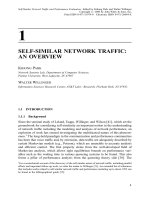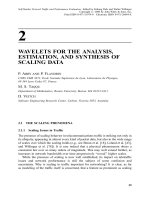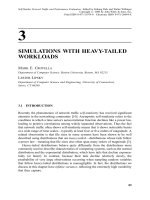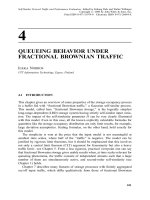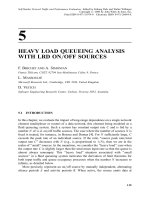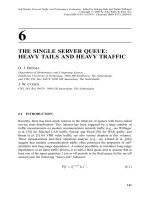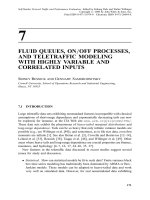Tài liệu Mạng lưới giao thông và đánh giá hiệu suất P1 doc
Bạn đang xem bản rút gọn của tài liệu. Xem và tải ngay bản đầy đủ của tài liệu tại đây (310.64 KB, 38 trang )
1
SELF-SIMILAR NETWORK TRAFFIC:
AN OVERVIEW
K
IHONG
P
ARK
Network Systems Lab, Department of Computer Sciences,
Purdue University, West Lafayette, IN 47907
W
ALTER
W
ILLINGER
Information Sciences Research Center, AT&T LabsÐResearch, Florham Park, NJ 07932
1.1 INTRODUCTION
1.1.1 Background
Since the seminal study of Leland, Taqqu, Willinger, and Wilson [41], which set the
groundwork for considering self-similarity an important notion in the understanding
of network traf®c includingthe modelingand analysis of network performance, an
explosion of work has ensued investigating the multifaceted nature of this phenom-
enon.
1
The long-held paradigm in the communication and performance communities
has been that voice traf®c and, by extension, data traf®c are adequately described by
certain Markovian models (e.g., Poisson), which are amenable to accurate analysis
and ef®cient control. The ®rst property stems from the well-developed ®eld of
Markovian analysis, which allows tight equilibrium bounds on performance vari-
ables such as the waitingtime in various queueingsystems to be found. This also
forms a pillar of performance analysis from the queueingtheory side [38]. The
Self-Similar Network Traf®c and Performance Evaluation, Edited by KihongPark and Walter Willinger
ISBN 0-471-31974-0 Copyright # 2000 by John Wiley & Sons, Inc.
1
1
For a nontechnical account of the discovery of the self-similar nature of network traf®c, includingparallel
efforts and important follow-up work, we refer the reader to Willinger [71]. An extended list of references
that includes works related to self-similar network traf®c and performance modelingup to about 1995 can
be found in the bibliographical guide [75].
Self-Similar Network Traf®c and Performance Evaluation, Edited by KihongPark and Walter Willinger
Copyright # 2000 by John Wiley & Sons, Inc.
Print ISBN 0-471-31974-0 Electronic ISBN 0-471-20644-X
second feature is, in part, due to the simple correlation structure generated by
Markovian sources whose performance impactÐfor example, as affected by the
likelihood of prolonged occurrence of ``bad events'' such as concentrated packet
arrivalsÐis fundamentally well-behaved. Speci®cally, if such processes are appro-
priately rescaled in time, the resultingcoarsi®ed processes rapidly lose dependence,
takingon the properties of an independent and identically distributed (i.i.d.)
sequence of random variables with its associated niceties. Principal amongthem
is the exponential smallness of rare events, a key observation at the center of large
deviations theory [70].
The behavior of a process under rescalingis an important consideration in
performance analysis and control since bufferingand, to some extent, bandwidth
provisioningcan be viewed as operatingon the rescaled process. The fact that
Markovian systems admit to this avenue of tamingvariability has helped shape the
optimism permeatingthe late 1980s and early 1990s regardingthe feasibility of
achievingef®cient traf®c control for quality of service (QoS) provisioning. The
discovery and, more importantly, succinct formulation and recognition that data
traf®c may not exhibit the hereto accustomed scalingproperties [41] has signi®-
cantly in¯uenced the networkinglandscape, necessitatinga reexamination of some
of its fundamental premises.
1.1.2What Is Self-Similarity?
Self-similarity and fractals are notions pioneered by Benoit B. Mandelbrot [47].
They describe the phenomenon where a certain property of an objectÐfor example,
a natural image, the convergent subdomain of certain dynamical systems, a time
series (the mathematical object of our interest)Ðis preserved with respect to scaling
in space and=or time. If an object is self-similar or fractal, its parts, when magni®ed,
resembleÐin a suitable senseÐthe shape of the whole. For example, the two-
dimensional (2D) Cantor set livingon A 0; 1Â0; 1 is obtained by startingwith
a solid or black unit square, scalingits size by 1=3, then placingfour copies of the
scaled solid square at the four corners of A. If the same process of scalingfollowed
by translation is applied recursively to the resultingobjects ad in®nitum, the limit set
thus reached de®nes the 2D Cantor set. This constructive process is illustrated in Fig.
1.1. The limitingobjectÐde®ned as the in®nite intersection of the iteratesÐhas the
property that if any of its corners are ``blown up'' suitably, then the shape of the
zoomed-in part is similar to the shape of the whole, that is, it is self-similar.Of
Fig. 1.1 Two-dimensional Cantor set.
2
SELF-SIMILAR NETWORK TRAFFIC: AN OVERVIEW
course, this is not too surprisingsince the constructive processÐby its recursive
actionÐendows the limitingobject with the scale-invariance property.
The one-dimensional (1D) Cantor set, for example, as obtained by projectingthe
2D Cantor set onto the line, can be given an interpretation as a traf®c series
X tPf0; 1gÐcall it ``Cantor traf®c''Ðwhere X t1 means that there is a packet
transmission at time t. This is depicted in Fig. 1.2 (left). If the constructive process is
terminated at iteration n ! 0, then the contiguous line segments of length 1=3
n
may
be interpreted as on periods or packet trains of duration 1=3
n
, and the segments
between successive on periods as off periods or absence of traf®c activity. Nonuni-
form traf®c intensities may be imparted by generalizing the constructive framework
via the use of probability measures. For example, for the 1D Cantor set, instead of
lettingthe left and right components after scalinghave identical ``mass,'' they may be
assigned different masses, subject to the constraint that the total mass be preserved at
each stage of the iterative construction. This modi®cation corresponds to de®ning a
probability measure m on the Borel subsets of 0; 1 and distributingthe measure at
each iteration nonuniformly left and right. Note that the classical Cantor set
constructionÐviewed as a mapÐis not measure-preserving. Figure 1.2 (middle)
shows such a construction with weights a
L
2
3
, a
R
1
3
for the left and right
Fig. 1.2 Left: One-dimensional Cantor set interpreted as on=off traf®c. Middle: One-
dimensional nonuniform Cantor set with weights a
L
2
3
, a
R
1
3
. Right: Cumulative process
correspondingto 1D on=off Cantor traf®c.
1.1 INTRODUCTION
3
components, respectively. The probability measure is represented by ``height''; we
observe that scale invariance is exactly preserved. In general, the traf®c patterns
producible with ®xed weights a
L
, a
R
are limited, but one can extend the framework
by allowing possibly different weights associated with every edge in the weighted
binary tree induced by the 1D Cantor set construction. Such constructions arise in a
more re®ned characterization of network traf®cÐcalled multiplicative processes or
cascadesÐand are discussed in Chapter 20. Further generalizations can be obtained
by de®ningdifferent af®ne transformations with variable scale factors and transla-
tions at every level in the ``traf®c tree.'' The correspondingtraf®c pattern is self-
similar if, and only if, the in®nite tree can be compactly represented as a ®nite
directed cyclic graph [8].
Whereas the previous constructions are given interpretations as traf®c activity
per unit time, we will ®nd it useful to consider their corresponding cumulative
processes, which are nondecreasingprocesses whose differencesÐalso called
increment processÐconstitute the original process. For example, for the on=off
Cantor traf®c construction (cf. Fig. 1.2 (left)), let us assign the interpretation that
time is discrete such that at step n ! 0, it ranges over the values t 0;
1=3
n
; 2=3
n
; ...; 3
n
À 1=3
n
; 1. Thus we can equivalently index the discrete time
steps by i 0; 1; 2; ...; 3
n
. With a slight abuse of notation, let us rede®ne X Á
as X i1 if, and only if, in the original process X i=3
n
1andX i=3
n
À e1
for all 0 < e < 1=3
n
. That is, for i values for which an on period in the original
process X t begins at t i=3
n
, X i is de®ned to be zero. Thus, in the case of n 2,
we have
X 00; X 11; X 20; X 31; X 40;
X 50; X 60; X 71; X 80; X 91:
Now consider the continuous time process Y t shown in Fig. 1.2 (right) de®ned
over 0; 3
n
for iteration n. Y t is nondecreasingand continuous, and it can be
checked by visual inspection that
X iY iÀY i À 1; i 1; 2; ...; 3
n
;
and X 0Y 00. Thus Y t represents the total traf®c volume up to time t,
whereas X i represents the traf®c intensity duringthe ith interval. Most importantly,
we observe that exact self-similarity is preserved even in the cumulative process.
This points toward the fact that self-similarity may be de®ned with respect to a
cumulative process with its increment processÐwhich is of more relevance for
traf®c modelingÐ``inheriting'' some of its properties including self-similarity.
An important drawback of our constructions thus far is that they admit only a
strongform of recursive regularityÐthat of deterministic self-similarityÐand needs
to be further generalized for traf®c modeling purposes where stochastic variability is
an essential component.
4
SELF-SIMILAR NETWORK TRAFFIC: AN OVERVIEW
1.1.3 Stochastic Self-Similarity and Network Traf®c
Stochastic self-similarity admits the infusion of nondeterminism as necessitated by
measured traf®c traces but, nonetheless, is a property that can be illustrated visually.
Figure 1.3 (top left) shows a traf®c trace, where we plot throughput, in bytes, against
time where time granularity is 100 s. That is, a single data point is the aggregated
traf®c volume over a 100 second interval. Figure 1.3 (top right) is the same traf®c
series whose ®rst 1000 second interval is ``blown up'' by a factor of ten. Thus the
truncated time series has a time granularity of 10 s. The remaining two plots zoom in
further on the initial segment by rescaling successively by factors of 10.
Unlike deterministic fractals, the objects correspondingto Fig. 1.3 do not possess
exact resemblance of their parts with the whole at ®ner details. Here, we assume that
the measure of ``resemblance'' is the shape of a graph with the magnitude suitably
normalized. Indeed, for measured traf®c traces, it would be too much to expect to
observe exact, deterministic self-similarity given the stochastic nature of many
network events (e.g., source arrival behavior) that collectively in¯uence actual
network traf®c. If we adopt the view that traf®c series are sample paths of stochastic
processes and relax the measure of resemblance, say, by focusingon certain statistics
of the rescaled time series, then it may be possible to expect exact similarity of the
mathematical objects and approximate similarity of their speci®c realizations with
respect to these relaxed measures. Second-order statistics are statistical properties
Fig. 1.3 Stochastic self-similarityÐin the ``burstiness preservation sense''Ðacross time
scales 100 s, 10 s, 1 s, 100 ms (top left, top right, bottom left, bottom right).
1.1 INTRODUCTION
5
that capture burstiness or variability, and the autocorrelation function is a yardstick
with respect to which scale invariance can be fruitfully de®ned. The shape of the
autocorrelation functionÐabove and beyond its preservation across rescaled time
seriesÐwill play an important role. In particular, correlation, as a function of time
lag, is assumed to decrease polynomially as opposed to exponentially. The existence
of nontrivial correlation ``at a distance'' is referred to as long-range dependence.A
formal de®nition is given in Section 1.4.1.
1.2PREVIOUS RESEARCH
1.2.1 Measurement-Based Traf®c Modeling
The research avenues relatingto traf®c self-similarity may broadly be classi®ed into
four categories. In the ®rst category are works pertaining to measurement-based
traf®c modeling [13, 26, 34, 42, 56, 74], where traf®c traces from physical networks
are collected and analyzed to detect, identify, and quantify pertinent characteristics.
They have shown that scale-invariant burstiness or self-similarity is an ubiquitous
phenomenon found in diverse contexts, from local-area and wide-area networks to IP
and ATM protocol stacks to copper and ®ber optic transmission media. In particular,
Leland et al. [41] demonstrated self-similarity in a LAN environment (Ethernet),
Paxson and Floyd [56] showed self-similar burstiness manifestingitself in pre-World
Wide Web WAN IP traf®c, and Crovella and Bestavros [13] showed self-similarity
for WWW traf®c. Collectively, these measurement works constituted strong
evidence that scale-invariant burstiness was not an isolated, spurious phenomenon
but rather a persistent trait existingacross a range of network environments.
Accompanyingthe traf®c characterization efforts has been work in the area of
statistical and scienti®c inference that has been essential to the detection and
quanti®cation of self-similarity or long-range dependence.
2
This work has speci®-
cally been geared toward network traf®c self-similarity [28, 64] and has focused on
exploitingthe immense volume, high quality, and diversity of available traf®c
measurements; for a detailed discussion of these and related issues, see Willinger
and Paxson [72, 73]. At a formal level, the validity of an inference or estimation
technique is tied to an underlyingprocess that presumably generated the data in the
®rst place. Put differently, correctness of system identi®cation only holds when the
data or sample paths are known to originate from speci®c models. Thus, in general, a
sample path of unknown origin cannot be uniquely attributed to a speci®c model,
and the main (and only) purpose of statistical or scienti®c inference is to deal with
this intrinsically ill-posed problem by concludingwhether or not the given data or
sample paths are consistent with an assumed model structure. Clearly, being
consistent with an assumed model does not rule out the existence of other models
that may conform to the data equally well. In this sense, the aforementioned works
on measurement-based traf®c modelinghave demonstrated that self-similarity is
2
The relationship between self-similarity and long-range dependenceÐthey need not be one and the
sameÐis explained in Section 1.4.1.
6
SELF-SIMILAR NETWORK TRAFFIC: AN OVERVIEW
consistent with measured network traf®c and have resulted in addingyet another
class of modelsÐthat is, self-similar processesÐto an already longlist of models for
network traf®c. At a practical level, many of the commonly used inference
techniques for quantifying the degree of self-similarity or long-range dependence
(e.g., Hurst parameter estimation) have been known to exhibit different idiosyncra-
sies and robustness properties. Due to their predominantly heuristic nature, these
techniques have been generally easy to use and apply, but the ensuing results have
often been dif®cult to interpret [64]. The recent introduction of wavelet-based
techniques to the analysis of traf®c traces [1, 23] represented a signi®cant step
toward the development of more accurate inference techniques that have been shown
to possess increased sensitivity to different types of scalingphenomena with the
ability to discriminate against certain alternative modeling assumptions, in particu-
lar, nonstationary effects [1]. Due to their ability to localize a given signal in scale
and time, wavelets have made it possible to detect, identify, and describe multifractal
scalingbehavior in measured network traf®c over ®ne time scales [23]: a nonuniform
(in time) scalingbehavior that emerges when studyingmeasured TCP traf®c over
®ne time scales, one that allows for more general scaling phenomena than the
ubiquitous self-similar scaling property, which holds for a range of suf®ciently large
time scales.
1.2.2 Physical Modeling
In the second category are works on physical modeling that try to explicate the
physical causes of self-similarity in network traf®c based on network mechanisms
and empirically established properties of distributed systems that, collectively,
collude to induce self-similar burstiness at multiplexingpoints in the network
layer. In view of traditional time series analysis, physical modelingaffects model
selection by pickingamongcompetingandÐin a statistical senseÐequally well-
®ttingmodels that are most congruent to the physical networkingenvironment where
the data arose in the ®rst place. Put differently, physical modelingaims for models of
network traf®c that relate to the physics of how traf®c is generated in an actual
network, is capable of explainingempirically observed phenomena such as self-
similarity in more elementary terms, and provides new insights into the dynamic
nature of the traf®c. The ®rst type of causalityÐalso the most mundaneÐis
attributable to the arrival pattern of a single data source as exempli®ed by variable
bit rate (VBR) video [10, 26]. MPEG video, for example, exhibits variability at
multiple time scales, which, in turn, is hypothesized to be related to the variability
found in the time duration between successive scene changes [25]. This ``single-
source causality,'' however, is peripheral to our discussions for two reasons: one,
self-similarity observed in the original Bellcore data stems from traf®c measure-
ments collected during1989±1991, a period duringwhich VBR video payload was
minimalÐif not nonexistentÐto be considered an in¯uencingfactor
3
; and two, it is
3
The same holds true for the LBL WAN data considered by Paxson and Floyd [56] and the BU WWW data
analyzed by Crovella and Bestavros [13].
1.2 PREVIOUS RESEARCH
7
well-known that VBR video can be approximated by short-range dependent traf®c
models, which, in turn, makes it possible to investigate certain aspects of the impact
on performance of long-range correlation structure within the con®nes of traditional
Markovian analysis [32, 37].
The second type of causalityÐalso called structural causality [50]Ðis more
subtle in nature, and its roots can be attributed to an empirical property of distributed
systems: the heavy-tailed distribution of ®le or object sizes. For the moment, a
random variable obeyinga heavy-tailed distribution can be viewed as giving rise to a
very wide range of different values, includingÐas its trademarkÐ``very large''
values with nonnegligible probability. This intuition is made more precise in Section
1.4.1. Returningto the causality description, in a nutshell, if end hosts exchange ®les
whose sizes are heavy tailed, then the resultingnetwork traf®c at multiplexingpoints
in the network layer is self-similar [50]. This causal phenomenon was shown to be
robust in the sense of holdingfor a variety of transport layer protocols such as
TCPÐfor example, Tahoe, Reno, and VegasÐand ¯ow-controlled UDP, which
make up the bulk of deployed transport protocols, and a range of network
con®gurations. Park et al. [50] also showed that research in UNIX ®le systems
carried out duringthe 1980s give strongempirical evidence based on ®le system
measurements that UNIX ®le systems are heavy-tailed. This is, perhaps, the most
simple, distilled, yet high-level physical explanation of network traf®c self-similarity.
Correspondingevidence for Web objects, which are of more recent relevance due to
the explosion of WWW and its impact on Internet traf®c, can be found in Crovella
and Bestavros [13].
Of course, structural causality would be meaningless unless there were explana-
tions that showed why heavy-tailed objects transported via TCP- and UDP-based
protocols would induce self-similar burstiness at multiplexingpoints. As hinted at in
the original Leland et al. paper [41] and formally introduced in Willinger et al. [74],
the on=off model of Willinger et al. [74] establishes that the superposition of a large
number of independent on=off sources with heavy-tailed on and=or off periods leads
to self-similarity in the aggregated processÐa fractional Gaussian noise processÐ
whose long-range dependence is determined by the heavy tailedness of on or off
periods. Space aggregation is inessential to inducing long-range dependenceÐit is
responsible for the Gaussian property of aggregated traf®c by an application of the
central limit theoremÐhowever, it is relevant to describingmultiplexed network
traf®c. The on=off model has its roots in a certain renewal reward process introduced
by Mandelbrot [46] (and further studied by Taqqu and Levy [63]) and provides the
theoretical underpinningfor much of the recent work on physical modelingof
network traf®c. This theoretical foundation together with the empirical evidence of
heavy-tailed on=off durations (as, e.g., given for IP ¯ow measurements [74])
represents a more low-level, direct explanation of physical causality of self-similarity
and forms the principal factors that distinguish the on=off model from other
mathematical models of self-similar traf®c. The linkage between high-level and
low-level descriptions of causality is further facilitated by Park et al. [50], where it is
shown that the application layer property of heavy-tailed ®le sizes is preserved by the
protocol stack and mapped to approximate heavy-tailed busy periods at the network
8
SELF-SIMILAR NETWORK TRAFFIC: AN OVERVIEW
layer. The interpacket spacingwithin a single session (or equivalently transfer=
connection=¯ow), however, has been observed to exhibit its own distinguishing
variability. This re®ned short time scale structure and its possible causal attribution
to the feedback control mechanisms of TCP are investigated in Feldmann et al. [22,
23] and are the topics of ongoing work.
1.2.3 Queueing Analysis
In the third category are works that provide mathematical models of long-range
dependent traf®c with a view toward facilitatingperformance analysis in the
queueingtheory sense [2, 3, 17, 43, 49, 53, 66]. These works are important in
that they establish basic performance boundaries by investigating queueing behavior
with long-range dependent input, which exhibit performance characteristics funda-
mentally different from correspondingsystems with Markovian input. In particular,
the queue length distribution in in®nite buffer systems has a slower-than-exponen-
tially (or subexponentially) decreasingtail, in stark contrast with short-range
dependent input for which the decay is exponential. In fact, dependingon the
queueing model under consideration, long-range dependent input can give rise to
Weibullian [49] or polynomial [66] tail behavior of the underlyingqueue length
distributions. The analysis of such non-Markovian queueingsystems is highly
nontrivial and provides fundamental insight into the performance impact question.
Of course, these works, in addition to providingvaluable information into network
performance issues, advance the state of the art in performance analysis and are of
independent interest. The queue length distribution result implies that bufferingÐas
a resource provisioningstrategyÐis rendered ineffective when input traf®c is self-
similar in the sense of incurringa disproportionate penalty in queueingdelay vis-a
Á
-
vis the gain in reduced packet loss rate. This has led to proposals advocating a small
buffer capacity=large bandwidth resource provisioningstrategy due to its simplistic,
yet curtailingin¯uence on queueing: if buffer capacity is small, then the ability to
queue or remember is accordingly diminished. Moreover, the smaller the buffer
capacity, the more relevant short-range correlations become in determining buffer
occupancy. Indeed, with respect to ®rst-order performance measures such as packet
loss rate, they may become the dominant factor. The effect of small buffer sizes and
®nite time horizons in terms of their potential role in delimitingthe scope of
in¯uence of long-range dependence on network performance has been studied
[29, 58].
A major weakness of many of the queueing-based results [2, 3, 17, 43, 49, 53, 66]
is that they are asymptotic, in one form or another. For example, in in®nite buffer
systems, upper and lower bounds are derived for the tail of the queue length
distribution as the queue length variable approaches in®nity. The same holds true for
``®nite buffer'' results where bounds on buffer over¯ow probability are proved as
buffer capacity becomes unbounded. There exist interestingresults for zero buffer
capacity systems [18, 19], which are discussed in Chapter 17. Empirically oriented
studies [20, 33, 51] seek to bridge the gap between asymptotic results and observed
behavior in ®nite buffer systems. A further drawback of current performance results
1.2 PREVIOUS RESEARCH
9
is that they concentrate on ®rst-order performance measures that relate to (long-
term) packet loss rate but less so on second-order measuresÐfor example, variance
of packet loss or delay, generically referred to as jitterÐwhich are of importance in
multimedia communication. For example, two loss processes may have the same
®rst-order statistic but if one has higher variance than the other in the form of
concentrated periods of packet lossÐas is the case in self-similar traf®cÐthen this
can adversely impact the ef®cacy of packet-level forward error correction used in the
QoS-sensitive transport of real-time traf®c [11, 52, 68]. Even less is known about
transient performance measures, which are more relevant in practice when conver-
gence to long-term steady-state behavior is too slow to be of much value for
engineering purposes. Lastly, most queueing results obtained for long-range depen-
dent input are for open-loop systems that ignore feedback control issues present in
actual networkingenvironments (e.g., TCP). Since feedback can shape and in¯uence
the very traf®c arrivingat a queue [22, 50], incorporatingtheir effect in feedback-
controlled closed queueingsystems looms as an important challenge.
1.2.4 Traf®c Control and Resource Provisioning
The fourth category deals with works relating to the control of self-similar network
traf®c, which, in turn, has two subcategories: resource provisioning and dimension-
ing, which can be viewed as a form of open-loop control, and closed-loop or
feedback traf®c control. Due to their feedback-free nature, the works on queueing
analysis with self-similar input have direct bearingon the resource dimensioning
problem. The question of quantitatively estimatingthe marginal utility of a unit of
additional resource such as bandwidth or buffer capacity is answered, in part, with
the help of these techniques. Of importance are also works on statistical multiplexing
usingthe notion of effective bandwidth, which point toward how ef®ciently
resources can be utilized when shared across multiple ¯ows [27]. A principal
lesson learned from the resource provisioningside is the ineffectiveness of allocating
buffer space vis-a
Á
-vis bandwidth for self-similar traf®c, and the consequent role of
short-range correlations in affecting ®rst-order performance characteristics when
buffer capacity is indeed provisioned to be ``small'' [29, 58].
On the feedback control side is the work on multiple time scale congestion
control [67, 68], which tries to exploit correlation structure that exists across
multiple time scales in self-similar traf®c for congestion control purposes. In spite
of the negative performance impact of self-similarity, on the positive side, long-
range dependence admits the possibility of utilizing correlation at large time scales,
transformingthe latter to harness predictability structure, which, in turn, can be
affected to guide congestion control actions at smaller time scales to yield signi®cant
performance gains. The problem of designing control mechanisms that allow
correlation structure at large time scales to be effectively engaged is a nontrivial
technical challenge for two principal reasons: one, the correlation structure in
question exists at time scales typically an order of magnitude or more above that
of the feedback loop; and two, the information extracted is necessarily imprecise due
10
SELF-SIMILAR NETWORK TRAFFIC: AN OVERVIEW
to its probabilistic nature.
4
Tuan and Park [67, 68] show that large time scale
correlation structure can be employed to yield signi®cant performance gains both for
throughput maximizationÐusing TCP and rate-based controlÐand end-to-end QoS
control within the framework of adaptive redundancy control [52, 68]. An important
by-product of this work is that the delay±bandwidth product problem of broadband
networks, which renders reactive or feedback traf®c controls ineffective when
subject to longround-trip times (RTT), is mitigated by exercisingcontrol across
multiple time scales. Multiple time scale congestion control allows uncertainty
stemmingfrom outdated feedback information to be compensated or ``bridged'' by
predictability structure present at time scales exceedingthe RTT or feedback loop
(i.e., seconds versus milliseconds). Thus even though traf®c control in the 1990s has
been occupied by the dual theme of large delay±bandwidth product and self-similar
traf®c burstiness, when combined, they lend themselves to a form of attack, which
imparts proactivity transcendingthe limitation imposed by RTT, thereby facilitating
the metaphor of ``catchingtwo birds with one stone.''
A related, but more straightforward, traf®c control dimension is connection
duration prediction. The works from physical modelingtell us that connections or
¯ows tend to obey a heavy-tailed distribution with respect to their time duration or
lifetime, and this information may be exploitable for traf®c control purposes. In
particular, heavy tailedness implies that most connections are short-lived, but the
bulk of traf®c is contributed by a few long-lived ¯ows [50]. By Amdahl's Law [4], it
becomes relevant to carefully manage the impact exerted by the long-lived ¯ows
even if they are few in number.
5
The idea of employing``connection'' duration was
®rst advanced in the context of load balancingin distributed systems where UNIX
processes have been observed to possess heavy-tailed lifetimes [30, 31, 40]. In
contrast to the exponential distribution whose memoryless property renders predic-
tion obsolete, heavy tailedness implies predictabilityÐa connection whose measured
time duration exceeds a certain threshold is more likely to persist into the future.
This information can be used, for example, in the case of load balancing, to decide
whether it is worthwhile to migrate a process given the ®xed, high overhead cost of
process migration [31]. The ensuing opportunities have numerous applications in
traf®c control, one recent example beingthe discrimination of long-lived ¯ows from
short-lived ¯ows such that routingtable updates can be biased toward long-lived
¯ows, which, in turn, can enhance system stability by desensitizingagainst ``trans-
ient'' effects of short-lived ¯ows [61]. In general, the connection duration informa-
tion can also come from directly available information in the application layerÐfor
example, a Web server, when servicinga HTTP request, can discern the size of the
object in questionÐand if this information is made available to lower layers,
decisions such as whether to engage in open-loop (for short-lived ¯ows) or closed-
loop control (for long-lived ¯ows) can be made to enhance traf®c control [67].
4
We remark that understandingthe correlation structure of network traf®c at time scales below the
feedback loop may be of relevance but remains, at this time, largely unexplored [22].
5
A form of Amdahl's Law states that to improve a system's performance, its functioningwith respect to its
most frequently encountered states must be improved. Conversely, performance gain is delimited by the
latter.
1.2 PREVIOUS RESEARCH
11
1.3 ISSUES AND REMARKS
1.3.1 Traf®c Measurement and Estimation
The area of traf®c measurementÐsince the collection and analysis of the original
Bellcore data [41]Ðhas been tremendously active, yieldinga wealth of traf®c
measurements across a wide spectrum of different contexts supportingthe view
that network traf®c exhibits self-similar scalingproperties over a wide range of time
scales. This ®ndingis noteworthy given the fact that networks, over the past decades,
have undergone signi®cant changes in their constituent traf®c ¯ows, user base,
transmission technologies, and scale with respect to system size. The observed
robustness property or insensitivity to changing networking conditions justi®ed
callingself-similarity a traf®c invariant and motivated focusingon underlying
physical explanations that are mathematically rigorous as well as empirically
veri®able. Robustness, in part, is explained by the fact that the majority of Internet
traf®c has been TCP traf®c, and while in the pre-WWW days the bulk of TCP traf®c
stemmed from FTP traf®c, in today's Internet, it is attributable to HTTP-based Web
traf®c. Both types of traf®c have been shown to transport ®les whose size
distribution is heavy-tailed [13, 56]. Physical modelingcarried out by Park et al.
[50] showed that the transport of heavy-tailed ®les mediated by TCP (as well as ¯ow-
controlled UDP) induces self-similarity at multiplexingpoints in the network layer;
it also showed that this is a robust phenomenon insensitive to details in network
con®guration and control actions in the protocol stack.
6
Measurement work has
culminated in re®ned workload characterization at the application layer, including
the modelingof user behavior [6, 7, 24, 48]. At the network layer, measurement
analyses of IP traf®c over ®ne time scales have led to the multifractal characteriza-
tion of wide-area network traf®c, which, in turn, has bearingon physical modeling
raisingnew questions about the relationship between feedback congestion control
and short-range correlation structure of network traf®c [22, 23]. The tracking of
Internet workload and its characterization is expected to remain a practically
important activity of interest in its own right. Demonstrating the relevance of ever
re®ned workload models to networkingresearch, however, will loom as a nontrivial
challenge.
As with experimental physics, the measurement- or data-driven approach to
networkingresearchÐrejuvenated by Leland et al. [41]Ðprovides a balance to the
more theoretical aspects of networkingresearch, in the ideal situation, facilitatinga
constructive interplay of ``give-and-take.'' A somewhat less productive consequence
has been the discourse on short-range versus long-range dependent mathematical
models to describe measured traf®c traces startingwith the original Bellcore
Ethernet data. At one level, both short-range and long-range dependent traf®c
models are parameterized systems that are suf®ciently powerful to give rise to
6
Not surprisingly, extremities in control actions and resource con®gurations do affect the property of
induced network traf®c, in some instances, diminishingself-similar burstiness altogether [50]. Moreover,
re®ned structure in the form of multiplicative scalingover sub-RTT time scales has only recently been
discovered [23].
12
SELF-SIMILAR NETWORK TRAFFIC: AN OVERVIEW
sample paths in the form of measured traf®c time series. Mathematical system
identi®cation, under these circumstances, therefore, is an intrinsically ill-posed
problem. Viewed in this light, the fact that different works can assign disparate
modelinginterpretations to the same measurement data, with differingconclusions,
is not surprising[26, 33]. Put differently, it is well known that with a suf®ciently
parameterized model class, it is always possible to ®nd a model that ®ts a given data
set. Thus, the real challenge lies less in mathematical model ®tting than in physical
modeling, an approach that in addition to describing the given data provides insight
into the causal and dynamic nature of the processes that generated the data in the
®rst place. On the positive side, the discussions about short-range versus long-range
dependence have brought out into the open concerns about nonstationary effects
[16]Ð3 p.m. traf®c cannot be expected to stem from the same source behavior
conditions as 3 a.m. traf®cÐthat can in¯uence certain types of inference and
estimation procedures for long-range dependent processes. These concerns have
spurned the development and adoption of estimation techniques based on wavelets,
which are sensitive to various types of nonstationary variations in the data [1]. What
is not in dispute are computed sample statisticsÐfor example, autocorrelation
functions of measured traf®c seriesÐwhich exhibit nontrivial correlations at time
lags on the order of seconds and above. Whether to call these time scales ``long
range'' or ``short range'' is a matter of subjective choice and=or mathematical
convenience and abstraction. What impact these correlations exert on queueing
behavior is a function of how large the buffer capacity, the level of traf®c intensity,
and link capacityÐamongother factorsÐare [29, 58]. As soon as one deviates from
empirical evaluation based on measurement data and adopts a model of the data, one
is faced with the same ill-posed identi®cation problem.
1.3.2Traf®c Modeling
There exist a wide range of mathematical models of self-similar or long-range
dependent traf®c each with its own idiosyncrasies [5, 21, 23, 35, 43, 49, 53, 59, 74].
Some facilitate queueinganalysis [43, 49, 53], some are physically motivated [5, 23,
74], and yet others show that long-range dependence may be generated in diverse
ways [21, 35]. The wealth of mathematical modelsÐwhile, in general, an assetÐcan
also distract from an important feature endowed on the networkingdomain: the
physics and causal mechanisms underlyingnetwork phenomena includingtraf®c
characteristics. Since network architectureÐeither by implementation or simula-
tionÐis con®gurable, from a network engineering perspective physical traf®c
models that trace back the roots of self-similarity and long-range dependence to
architectural properties such as network protocols and ®le size distribution at servers
have a clear advantage with respect to predictability and veri®ability over ``black
box'' models associated with traditional time series analysis. Contrast this with, say,
economic systems where human behavior cannot be reprogrammed at will to test the
consequences of different assumptions and hypotheses on system behavior. Physical
models, therefore, are in a unique position to exploit this ``recon®gurability trait''
1.3 ISSUES AND REMARKS
13
afforded by the networkingdomain, and use it to facilitate an intimate, mechanistic
understandingof the system.
The on=off model [74] is a mathematical abstraction that provides a foundation
for physical traf®c modelingby advancingan explicit causal chain of veri®able
network properties or events that can be tested against empirical data. For example,
the factual basis of heavy-tailed on periods in network traf®c has been shown by
Willinger et al. [74], a corresponding empirical basis for heavy-tailed ®le sizes in
UNIX ®le systems of the past whose transport may be the cause of heavy-tailed on
periods in packet trains has been shown by Park et al. [50], and a more modern
interpretation for the World Wide Web has been demonstrated by Crovella and
Bestavros [13]. One weakness of the on=off model is its assumption of independence
of on=off sources. This has been empirically addressed [50] by studyingthe
in¯uence of dependence arisingfrom multiple sources coupled at bottleneck routers
sharing resources when the ¯ows are governed by feedback congestion control
protocols such as TCP in the transport layer. It was found that couplingdid not
signi®cantly impact long-range dependence. A more recent study [22] shows that
dependence due to feedback and inter¯ow interaction may be the cause for multi-
plicative scalingphenomena observed in the short-range correlation structure, a
re®ned physical characterization that may complement the previous ®ndings, which
focused on coarser structure at larger time scales. We remark that the on=off model is
able to induce both fractional Gaussian noiseÐupon aggregation over multiple ¯ows
and normalizationÐand a form of self-similarity and long-range dependence called
asymptotic second-order self-similarityÐa single process with heavy-tailed on=off
periodsÐwhich constitute two of the most commonly used self-similar traf®c
models in performance analysis.
Finally, physical models, because of their grounding in empirical facts, in¯uence
the general argument advanced in Section 1.3.1 on the ill-posed nature of the
identi®cation problem. They can be viewed as tilting the scale in favor of long-range
dependent traf®c models. That is, since ®le sizes in various network related contexts
have been shown to be heavy-tailed and the physical modelingworks show that
resulting traf®c is long-range dependent, other things being equal, empirical
evidence afforded by physical models biases toward a more consistent and
parsimonious interpretation of network traf®c as being long-range dependent as
opposed to the mathematically equally viable short-range dependence hypothesis.
Thus physical models, by virtue of their casual attribution, can also in¯uence the
choice of mathematical modelingand performance analysis.
1.3.3 Performance Analysis and Traf®c Control
The works on queueinganalysis with self-similar input have yielded fundamental
insights into the performance impact of long-range dependence, establishing the
basic fact that queue length distribution decays slower-than-exponentially vis-a
Á
-vis
the exponential decay associated with Markovian input [2, 3, 17, 43, 49, 53, 66]. In
conjunction with observations advanced by Grossglauser and Bolot [29] and Ryu
and Elwalid [58] on ways to curtail some of the effect of long-range dependence, a
14
SELF-SIMILAR NETWORK TRAFFIC: AN OVERVIEW
very practical impact of the queueing-based performance analysis work has been the
growing adoption of the resource dimensioning paradigm, which states that buffer
capacity at routers should be kept small while link bandwidth is to be increased. That
is, the marginal utility of buffer capacity has diminished signi®cantly vis-a
Á
-vis that
of bandwidth. This is illustrated in Fig. 1.4, which shows mean queue length as a
function of buffer capacity at a bottleneck router when fed with self-similar input
with varying degrees of long-range dependence but equal traf®c intensity (roughly, a
values close to 1 imply ``strong'' long-range dependence whereas a values close to 2
correspond to ``weak'' long-range dependence). In other words, when long-range
correlation structure is weak, a buffer capacity of about 60 kB suf®ces to contain the
input's variability and, moreover, the average buffer occupancy remains below 5 kB.
However, when the long-range correlation structure is strong, an increase in buffer
capacity is accompanied by a correspondingincrease in buffer occupancy with the
buffer capacity horizon at which the mean queue length saturates pushed out
signi®cantly.
In spite of the fundamental contribution and insight afforded by queueing
analysis, as a practical matter, all the known results suffer under the limitation
that the analysis is asymptotic in the buffer capacity: either the queue is assumed to
be in®nite and asymptotic bounds on the tail of the queue length distribution are
derived, or the queue is assumed to be ®nite but its over¯ow probability is computed
as the buffer capacity is taken to in®nity. There is, as yet, a chasm between these
asymptotic results and their ®nitistic brethren that have alluded tractability. It is
unclear whether the asymptotic formulasÐbeyond their qualitative relevanceÐare
also practically useful as resource provisioningand traf®c engineeringtools. Further
work is needed in this direction to narrow the gap. Another signi®cant drawback of
the performance analysis resultsÐalso related to the asymptotic nature of queueing
Fig. 1.4 Mean queue length as a function of buffer capacity for input traf®c with varying
long-range dependence a 1:05, 1.35, 1.65, 1.95).
1.3 ISSUES AND REMARKS
15

